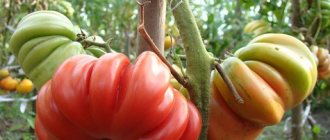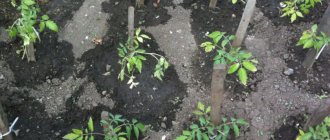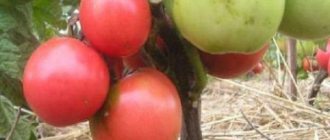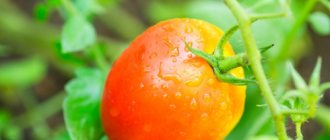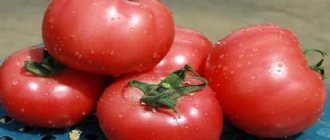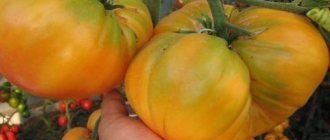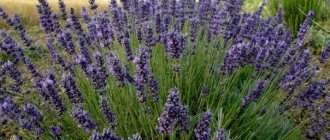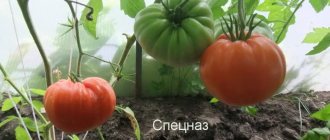The amazing, bright, fleshy tomato Amana orange (original name - Amana orange), which in 2016 at the tomato festival in America entered the "Top 10" most delicious, beating more than 600 other species, of course conquered Russians too beef tomato lovers. This orange miracle comes from the USA, the name of the man who discovered it for vegetable growers is Gary Haley (Staley). This person, in addition to his main job, is interested in collecting and growing unusual tomatoes. One day he received another batch of seeds, planted them, and when the harvest was ripe, he was delighted with one of the varieties - its fruits were so bright and large. For another 3 seasons, a keen vegetable grower grew this variety to confirm its characteristics. And so, in 1984, the new product was presented by him at the Seed Savers seed exchange. The unusual name of the variety is given in honor of the German colony settlement of Amana, located in Iowa, where Gary worked for some time. The overseas guest was not included in the State Register of Breeding Achievements of Russia. Russian tomato growers prefer to grow it in protected soil, where the orange guest feels much more comfortable. Our hero is a varietal crop.
Description
Amana Orange is a large-fruited variety that is classified as so-called beef tomatoes. The average fruit weight is 400-550 g. With the right approach, the weight of tomatoes can reach 1 kg. The shape of the fruit is round-flat, strongly ribbed.
The first flowering shoot appears above the ninth leaf, the next ones - every three leaves. Up to five to six fruits are tied to the cluster. The surface of the leaves is matte, slightly wrinkled. The foliage is of ordinary shape, large, dark green in color.
Tomatoes are usually classified as mid-season varieties. The period from the formation of the first shoots to the onset of fruit ripeness is about 110 days, from the time of planting seeds for seedlings in the soil - about 45 days. The height of the bushes is up to 2 m. The inflorescences of the variety are of an intermediate type.
Main characteristics
The originator of the Amana Orange variety claims that the tomato is quite productive. With proper agricultural technology, from 1 sq. m harvest up to 15-18 kg of fruit. Reviews from summer residents confirm that the tomato variety really bears fruit generously and produces up to 3.5-4 kg of sweet harvest per bush.
But this is where Amana Orange tomatoes continue to delight. Plants take root well and are highly resistant to various diseases, including viral and fungal ones. However, late blight of leaves and fruits still occurs, but it is easy to cope with.
However, these tomatoes are not suitable for industrial cultivation. The Amana Orange variety is rather an amateur one. The fruits do not tolerate transportation well, are easily wrinkled, and their presentation quickly deteriorates. And the keeping quality of tomatoes lets us down. When fresh, they do not last long; they should be immediately processed or used in salads.
Advantages and disadvantages
From all of the above, we can conclude about the advantages of the variety, of which there are quite a few:
- high productivity;
- excellent taste of fruits;
- good immunity;
- crack resistance.
But Amana Orange tomatoes also have disadvantages, and you shouldn’t keep silent about them. These include:
- poor keeping quality of fruits and impossibility of transportation;
- short shelf life;
- need for stepsoning;
- sensitivity to weather conditions.
However, these are not such significant disadvantages as to give up growing tomatoes of this variety.
Landing
Seedlings that are two months old are considered suitable for planting. Of course, the timing will vary depending on weather conditions in a particular area. The site must be prepared in advance, in particular, dug up and fertilized. The beds are usually placed in the most illuminated area of the greenhouse. It is necessary that the distance between planting holes in a row be at least 40 cm. Three to four seedlings should be planted per 1 m².
It is worth noting that it is customary to plant seedlings that are too elongated by placing them in the planting hole as deep as possible or at a significant slope.
It is not recommended to plant Amana Orange in beds where crops such as:
- potato,
- parsley,
- dill.
Growing seedlings
Many people ask: “When should I plant seeds for seedlings?” This will directly depend on the cultivation conditions. When growing in a greenhouse, sowing should be done in the last week of February. During cultivation in open ground, sowing must be done in mid-March.
When organizing a comfortable temperature, the seed material of the variety does not need additional stimulation before sowing. However, it is advisable to weed out unsuitable seed material. It should be noted that only the largest samples need to be sown.
Sowing of seed material is carried out in peat pots, glasses or specially prepared containers. As soon as the first pair of leaves appears, the young plant should be replanted, this is necessary for faster root growth. In addition, thanks to the Amana transplant, Orange better tolerates the “moving” to a permanent place.
Landing in the ground
Seedlings two months old are considered suitable for planting in the ground. As the plant grows, it will need support, and both the stem and the fruit clusters need support, since under the load of ripening fruit the clusters can break at the point of attachment to the stem. To grow indoors, it will be necessary to carefully observe the irrigation regime.
Reviews from specialists and vegetable growers about the Amana Orange variety
Austin Van Vader (USA)
In 2016, at a festival in Oakland (USA), promising varieties were assessed. The report by Austin Van Vader (professor from Iowa) said the following:
... Among the presented samples of tomatoes for year-round cultivation, I draw the attention of entrepreneurs to the Amana Orange variety. It is distinguished from others by a number of advantages. Fruits can retain their natural appearance for up to 15 days from the date of harvest. They do not accumulate the pesticides that our farmers love to use. Vitamins A and C are retained throughout the warranty period. There is also folic acid, which is extremely necessary for growing organisms and elderly people...
Professor Kukta I.A. (Kyiv City)
In his writings, Joseph Andreevich Kukta noted that among the new varieties that have recently come from abroad, it is worth paying attention to the orange types. Amana Orange is especially interesting. Its consumer properties are many times superior to their pink and dark red counterparts. They should be cultivated throughout the CIS.
Tomato has excellent resistance to late blight. It produces magnificent and juicy fruits with a high content of vitamins necessary for humans.
Care
First of all, the procedure for watering the bushes is very important. Watering is carried out in the evening or in the morning; for this you should use warm, settled water. The soil under tomatoes must be moist and slightly loose, but most often it is necessary to water at the stage of crop formation. At the same time, you should not moisten the soil too much, otherwise the tomatoes will crack. It is necessary to water the bed two to three times a week, this will moisten the soil to the entire depth of the roots. Upon completion of watering procedures, it is imperative to loosen the soil so that it can properly conduct air to the roots.
Particular attention must be paid to the formation of bushes; the yield will directly depend on this. As a rule, tomatoes are grown in one or two stems; excess shoots are removed, leaving a centimeter stump so that they do not grow again.
It is also worth mentioning that you need to use additional preventative sprayers against pests. In most cases, standard medications are used, diluted in accordance with the instructions.
Features of the variety
Tall bushes can reach a length of more than two meters. Vertical alignment on supports is required. Therefore, they become widespread as greenhouse plants.
The name of the tomatoes indicates that the main color of the fruit will be orange. The appearance of the resulting fruit is round, slightly crushed. Typically, this shape is typical for salad tomatoes.
A small amount of seeds. On average there are no more than 20...30. There are no large voids around the placenta. Lots of solid pulp.
Researchers indicate that the moisture content in the fleshy part is up to 94...96%. There is a significant amount of sugar present. There is a typical tomato smell with some hint of fruity flavor, possibly similar to apple.
Seed preparation
Before planting, the planting material is sorted. Select tomato seeds of large size and regular shape.
Before sowing, the selected specimens are wrapped in several layers of gauze and immersed for 20 minutes in a warm manganese solution for disinfection. After time, the seeds, without removing them from the fabric, are thoroughly washed in running water.
You can also use a growth stimulator. To do this, apply the solution, moisten a cloth in it and place tomato seeds on it. The top of the fabric is covered with polyethylene and left in a warm place for a day. Then the seed is placed in the refrigerator for 4 hours to harden and increase immunity. This procedure is carried out 3 times until the sprouts are visible. After this, landing is carried out.
Important! Orange Blue tomato seeds can be checked for suitability before sowing. To do this, they are immersed in water.
Any seeds that float to the surface are removed, and those remaining at the bottom are dried and used for planting.
How to grow
- Orange tomato seeds are prepared in advance for sowing, taking into account the reviews of experienced farmers. It is worth counting 6 or 8 weeks from the time of transplantation and carrying out sowing work.
- The grooves for the seeds are made shallow so that it is easy for the plant to hatch. The soil should be well moistened and the soil should be warmed up in advance. You can see the first shoots in a week. If the storage conditions of the container with the sown crop were not ideal, you should wait two weeks until the seedlings appear.
- This is followed by the germination process on the windowsill, where the crop will be warm and light enough for normal development. Gardeners can also grow the plant under lamps, which should be left on for 16 hours a day. At this stage, the plant does not need a lot of fertilizer. The first fertilizing is carried out three weeks from the moment of sowing. A water-soluble universal material is used for these purposes.
- For better transplantation and reducing the stress factor for the crop, it is necessary to harden the seedlings. Place seedlings outside for several hours a day only in places where there is sun and no drafts.
- When planting Orange tomatoes, taking into account recommendations, characteristics and reviews, it is worth adhering to crop rotation so as not to expose the crop to the risk of developing various diseases. Each bush is planted at a distance of 40 cm from the other. It is not worth planting bushes that are bushier, so as not to complicate the care process and not to interfere with the plant’s normal development.
- Experienced gardeners prefer to plant seedlings deep so that the root system can grow better and have a better chance of coping with prolonged drought. The replanting process is completed with thorough irrigation, which helps dislodge air pockets from the soil and allows for faster rooting in the new location. In a month, powerful bushes will need a small but reliable support.
Agricultural technology
It is recommended to grow Amana orange in seedlings. It is better to calculate the planting date yourself to take into account the climatic features of the region. Seedlings that are two months old are suitable for transplanting into the ground. During the growth process, the crop will need support, and it is necessary to tie up not only the stem, but also the fruit clusters, since under the weight of ripening fruits they can break at the point of attachment to the stem. Recommended planting density: 3 - 4 plants per 1 square meter. The variety will show the best results when formed into 1 or 2 stems. Tomatoes need to be planted in the brightest corner of the greenhouse. Growing in protected soil will require compliance with the watering regime. The soil should not be waterlogged. During the process of fruit ripening, the amount of moisture is slightly reduced so that the fruits do not crack and retain their sweet taste. The yield also needs to be supported with fertilizers; you can use mineral or organic fertilizers. Despite the good resistance to disease, do not forget that our hero belongs to varietal plants. Therefore, treatments, at least with biological products, must be carried out.
Amazing Amana orange is very loved by tomato growers all over the world, so the variety is in the collection of most of them. This large-fruited crop with bright, tasty tomatoes will not disappoint even beginners with its yield and will not burden you with the hassle of care. And experienced vegetable growers can practice growing giant specimens, to the envy of their neighbors and to the delight of their households. Apart from the inability to transport crops over long distances, no criticisms were identified. The variety is ideal for growing in private farms. Moreover, the quality of the seed material can be controlled independently by selecting the most beautiful tomatoes.
In the nineties of the last century, several interesting varieties were bred in the experimental beds of the Iowa State Agricultural Biological Laboratory. Among them, orange fruits stood out for their size.
The attractive appearance was accompanied by a pronounced tomato taste. The head of the laboratory, Amana Rubeira, decided to name this tomato variety after herself. Therefore, gardeners know it under the name Amana Orange (orange, red).
Garden-grown salad tomatoes are most often used to make salad. Therefore, such tomatoes are always in demand among the population.
Many summer residents consider them for planting on their own plots. Unpretentious fruits are easy to grow in greenhouses. In the southern regions they can be planted in open ground. It’s worth taking a closer look at this variety.
Growing rules
Growing Orange tomatoes is not at all difficult and it is quite possible to get a rich harvest. All you need is to choose the right site for planting, pre-prepare the soil and seeds, transplant the seedlings in a timely manner and carry out proper care. By following these simple recommendations, a rich tomato yield is guaranteed.
Soil preparation
The soil for tomatoes should be prepared in the fall. To do this, carefully dig up the soil and apply the necessary fertilizers. In the spring, just before planting the seedlings, the soil is dug up again and fertilizers are applied again to speed up the growth and development of the tomato.
When choosing a site for planting this vegetable, it is better to choose those places where onions, cabbage or eggplants grew last year. Do not plant where tomatoes, as well as any nightshade crops and corn, were already growing.
The area for Orange tomatoes should be sufficiently illuminated by sunlight, have small screens to protect the plants from the wind, and low areas should be excluded. Because moisture accumulates in them, which can lead to blackleg, rot and other diseases.
To plant Orange tomato seeds, soil can be purchased ready-made or you can make it yourself. To do this, you need to mix the following components, such as peat, wood ash, sawdust and turf soil.
The prepared substrate is laid out in special boxes or plastic containers and the seeds are sown.
Note! The soil for growing Orange tomatoes should be chosen with low acidity or neutral.
